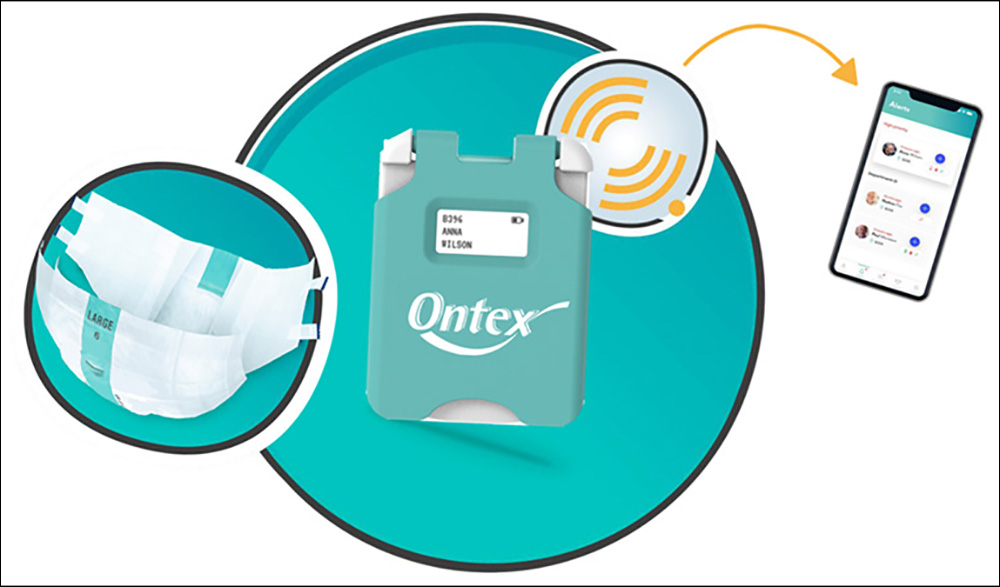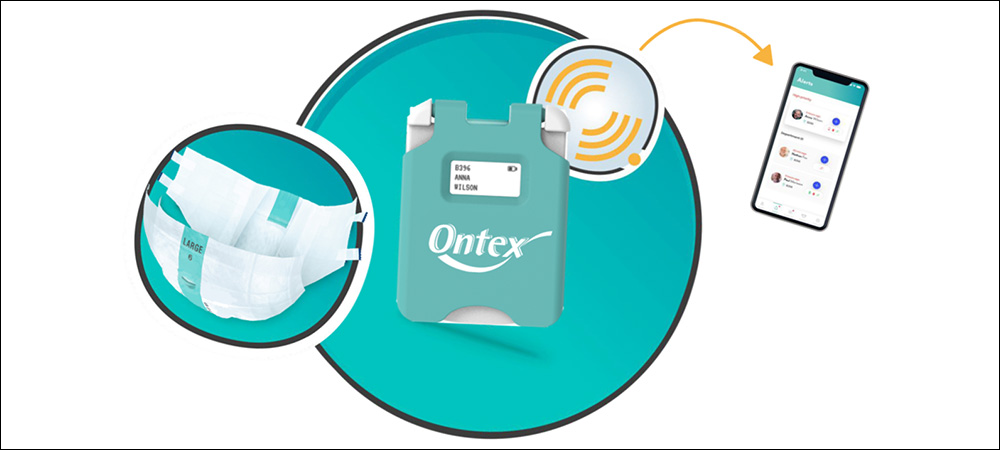- Aging Population Adds Strain to Limited Healthcare Resources
- Moisture Sensor Sends Status Updates Wirelessly
- Improving Dignity and Comfort for Patients
Internet of Things (IoT) technology has been providing support to the healthcare sector for managing assets, patients and inventory, as well as for ensuring proper hand hygiene by staff members who care for patients. Recently, care facilities in Belgium have been piloting an IoT-based system for another long-standing challenge: the management of hygiene for incontinent adult patients.
Personal hygiene company Ontex released its IoT-based diaper system to let care facility or hospital employees know which patients require a diaper change, enabling them to save labor and provide better care to those patients. The company’s Orizon solution consists of its printed moisture sensors and LoRaWAN transmitters, worn by patients, along with data management in a cloud-based server. Users can view the status and receive alerts related to the care of their patients or residents via an app.

Ontex’s smart diaper system
Data is transmitted from the diaper device to gateways using LoRa ICs provided by semiconductor company Semtech. The company’s SX1261 chip is built into the device that transmits from the diaper, and the gateway receives that LoRaWAN transmission—an IC that is part of Semtech’s LoRa Core portfolio. Zenso Electronics served as Ontex’s design partner for the electronics. Ontex and Zenso developed the solution, leveraging Semtech’s LoRa reference design and application notes, according to Marc Pégulu, Semtech’s VP of IoT strategy and products.
Ontex is an international personal hygiene group that manufactures solutions and products, such as pads and diapers, for baby care, as well as for feminine and incontinence care. The company, founded in Belgium in 1979 as a supplier of under-pads for hospitals, clinics and care homes, has since grown. It now provides more than two billion euros’ worth of product and services worldwide annually. These days, Ontex has offices and manufacturing plants on five continents, and its products are available in more than 110 countries, according to Maarten Verbanck, the firm’s global external communications manager.
Aging Population Adds Strain to Limited Healthcare Resources
Ontex went public in June 2014. The company is constantly exploring new market opportunities, Verbanck says, with a key interest in innovation. Ontex chose to deploy a smart diaper solution for incontinence as part of its services for institutional customers, such as care facilities and hospitals. Such facilities, he explains, are being challenged on several fronts. The aging population means more elderly patients putting demands on healthcare systems around the globe, along with limited healthcare budgets. At the same time, there is a shortage of workers to provide the day-to-day care of such individuals. Therefore, the company released its Orizon continence-care solution.

Maarten Verbanck
The system is designed to provide connected care to increase the dignity of residents and patients, as well as improve the satisfaction of employees and reduce caregiver labor costs. Before Ontex began developing the smart diaper, it conducted market research, which consisted of interviewing caregivers, nursing facility management, patients and family members. “Based on the qualitative and quantitative results,” Verbanck says, “Ontex did not develop just another piece of technology, but a holistic concept that helps to optimize care quality and caregivers’ workflows and achieve economical material consumption.”
The system is designed to be customized for each nursing home, the company reports, as well as for each patient. The sensing technology can be integrated into various product concepts, Ontex explains, though the company is only providing the solution for adult incontinence care so far. The system is designed so that more functions can be added in the future.
Ontex created a printed-electronics wetness sensor that can be integrated into a smart diaper that it manufactures in-house. The transmitter, based on Ontex’s design and Semtech’s LoRaWAN IC, is then attached to the diaper by a caregiver as it is being fitted onto the patient. Ontex provides the software and app related to managing the sensor data, and it has established partnerships with manufacturing companies for the devices.
Moisture Sensor Sends Status Updates Wirelessly
When an individual wears the smart diaper, its integrated wetness sensor continually monitors the moisture status within the absorbent core. The sensor is designed to detect not only whether moisture is present, but also how much and how it is spread. The user’s posture, for instance, impacts the distribution of liquid and the risk for leaks, and the sensor can send the related reading to a gateway via the LoRaWAN sensor attached to the diaper. The data, forwarded to a server, is interpreted and managed in the software. The system is intended to spare the patients from being checked unnecessarily, such as at nights when they are sleeping.
Ontex has a team of software developers, Verbanck says—what the company refers to as its in-house digital factory. The cloud-based back-end system runs Ontex’s tailor-made wetness-detection algorithm. The team has also created the mobile app and a Web-based application for the user interface. When a diaper requires management, caregivers can use an app that provides a traffic-light indicator and alerts to indicate which patient requires assistance and when they need to visit that individual. The software can also monitor conditions over time and provide management with details about events and responses historically.
Once a diaper is changed, its transmitter can be reused. “It was important for us to design an ecofriendly system with devices that are not disposable,” Verbanck says, “but having rechargeable batteries for a long product lifetime.” The diaper contains no electronic components, just a fully disposable conductive print layer. Since its development, the product has achieved certification for use with patients by government authorities. This required the company to clarify which IoT sub-bands must be used in order for the solution to pass the certification.
In most cases, Pégulu says, a single gateway can manage data within a facility for potentially thousands of devices. That, however, depends on how often devices transmit. “There are practical limits to a single gateway in terms of messages per minute,” he explains, but if transmission congestion were ever an issue, users could simply plug in another gateway to increase capacity.
Improving Dignity and Comfort for Patients
The system has been tested at nursing homes in Belgium, the company reports, and it is slated to be rolled out later this year with more pilot cases in different countries throughout Europe. In each case, the facilities will deploy gateways to create a local LoRa network and link to the cloud-based back-end system. Since the solution was released, Verbanck says, “We definitely see high interest in this product. We will start within the institutional market for nursing homes, and we will consider extending to other options in the future.”
For caregivers, Verbanck anticipates the solution making their work more efficient, “because it is easy to see where care support is needed.” Reducing or preventing leakage is critical, he adds, as such situations not only are embarrassing for patients and frustrating for caregivers, but also cause significant cleaning efforts and additional costs. For patients, he says, the most important point is to receive a high level of care without unnecessary interruptions to nighttime routines.
At the same time, Verbanck says, family members may gain some comfort from knowing the technology is helping to ensure their loved ones are being properly cared for. The system is also intended to reduce the number of products that are changed and disposed of, in some cases unnecessarily.
Key Takeaways:
- IoT can reduce the need for caregivers to check adult diapers thereby saving their time for other caregiving tasks.
- With the technology patients can rest undisturbed until the diaper actually needs changing.
Exhibitors at RFID Journal LIVE! 2022 will offer RFID and IoT solutions for use at healthcare facilities. To learn more, visit the event’s website.


